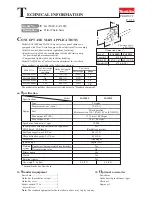
8
“SAVE THESE INSTRUCTIONS”
Additional Safety Rules
Electrical Requirements
•
Connect this saw to a 120V, 15-amp branch
circuit with a 15-amp fuse or circuit breaker.
Using the wrong size fuse can damage the motor.
•
Fuses may “blow” or circuit breakers may trip
frequently if motor is overloaded. Overloading
can occur if you feed the blade into the
workpiece too rapidly or start and stop too often
in a short time.
•
Most motor troubles may be traced to loose or
incorrect connections, overload or low voltage
(such as small size wire in the supply circuit or
overly long supply circuit wire). Always check the
connections, the load and the supply circuit
whenever motor does not work well.
▶ Electric Brake
Your saw is equipped with an automatic electric brake
which is designed to stop the blade from spinning in
about five (5) seconds after you release the trigger
switch. It is useful when making certain cuts in wood
where a coasting blade would result in a wide,
imprecise cut.
When electrical power is lost
due to blown fuse or other
causes, the motor will gradually slow down and the
braking action is initiated ONLY by the release of
the trigger switch.
The electric blade brake of your miter saw has been
designed for highest degree of reliability, but
unexpected circumstances such as contamination on
the commutator and brushes or failure of motor’s
components can cause the brake not to activate. If
this condition occurs, turn the saw “ON” and “OFF”
four to five times without contacting the workpiece.
If the tool operates but the brake does not
consistently stop the blade in about five seconds, DO
NOT use saw and have it serviced immediately.
The brake action of this saw is
not
intended
as
a
safety
feature. Remember to let the saw blade come to a
complete stop before raising the blade from the
workpiece. As always, the guard system is your
best protection against unintentional contact with a
spinning saw blade. NEVER wedge open or defeat
the closing action of the lower guard.
Do Not Carry the
Saw by this handle.
No lleve la sierra
por este mango.
Ne transportez pas la
scie par sa poignée.
DESIGNATED DANGER ZONES
DESIGNATED PINCH POINT AREA
DESIGNATED NO-CARRY AREA
Avoid positioning hands, fingers or
arms
A danger zone – avoid placing
hands, fingers or arms in these
areas. never attempt to move or lift
the saw in these areas.
A danger zone – never lift or carry
saw by the main switch handle.
Before each use, review all warnings
located on the miter saw.
2610051885.qxp_CM10GD 12/3/18 8:49 AM Page 8









































